 Let’s
get one thing straight from the get-go. If you’re expecting to read
about Shadow Man as a spin-off from the popular Valiant Heroes
comic title, or about the particulars of the Shadow-Man story—that
Shadow Man is the heroic alter-ego of the shamed Mike LeRoi, a failed
English Literature student and New Orleans hitman, that the voodoo
priestess Nettie fused a voodoo mask to his sternum, or that this mask
gives LeRoi the power to move between the realms of Liveside and Deadside—then
find something else to read. See, I’m only going to talk about one thing
in respect to Shadow Man.
Let’s
get one thing straight from the get-go. If you’re expecting to read
about Shadow Man as a spin-off from the popular Valiant Heroes
comic title, or about the particulars of the Shadow-Man story—that
Shadow Man is the heroic alter-ego of the shamed Mike LeRoi, a failed
English Literature student and New Orleans hitman, that the voodoo
priestess Nettie fused a voodoo mask to his sternum, or that this mask
gives LeRoi the power to move between the realms of Liveside and Deadside—then
find something else to read. See, I’m only going to talk about one thing
in respect to Shadow Man.
Shadow Man scares the bejaysus out of this gamer.
 That’s right. Shadow
Man has got to be the spookiest game I’ve ever played, and the point
is worth noting for at least two reasons. One, ‘tis the season;
Halloween is right around the corner, and if you’ve tired of the lame
costume soirees and the obligatory movie marathons every cable channel
broadcasts on All Souls’, then pick up Shadow Man and lose sleep
for weeks. Two, it’s a testament to Acclaim’s potential that they have
produced an entertainment in which every aspect of the gaming environment—from
the story to the gameplay to the graphics to the sound—is so superb that
it, like the voodoo mask fused to Mike’s ribcage, grafts itself to a
player’s subconscious and renders certain waking moments—hearing
unfamiliar noises, noticing flickering shadows—horrifying.
That’s right. Shadow
Man has got to be the spookiest game I’ve ever played, and the point
is worth noting for at least two reasons. One, ‘tis the season;
Halloween is right around the corner, and if you’ve tired of the lame
costume soirees and the obligatory movie marathons every cable channel
broadcasts on All Souls’, then pick up Shadow Man and lose sleep
for weeks. Two, it’s a testament to Acclaim’s potential that they have
produced an entertainment in which every aspect of the gaming environment—from
the story to the gameplay to the graphics to the sound—is so superb that
it, like the voodoo mask fused to Mike’s ribcage, grafts itself to a
player’s subconscious and renders certain waking moments—hearing
unfamiliar noises, noticing flickering shadows—horrifying.
 In brief, Shadow
Man is the story about the aforementioned Mike LeRoi, a screw-up who
is forced into fostering under- and otherworld connections during his
quest for redemption from the guilt he bears as a result of having
initiated the deaths of his mom, dad and little brother, Luke. All he
possesses from his shameful past is Luke’s teddy bear, which becomes the
totem that provides his connection to the Deadside, the "place beyond
death, where every soul that has ever shuffled off this mortal coil finds
its spiritual home" (Shadow Man Instruction Booklet,
5). During the course of his quest, he becomes the agent and lover of
Nettie, a centuries-old voodoo priestess who has powerful stakes in
Deadside, but is unable to go there herself. This is where Mike, as Shadow
Man, enters the picture, holding the forces of evil at bay on Nettie’s
behalf. In exchange, he gets the opportunity to salvage a shred of his
damned soul. Time is running out, though, and the infinite, immortal
manifestations of evil, referring to themselves singularly as Legion,
threaten to overrun Liveside, the realm of mortal existence in all its
banality and beauty. It is Mike/Shadow Man’s responsibility to see that
this course of action doesn’t come to pass.
In brief, Shadow
Man is the story about the aforementioned Mike LeRoi, a screw-up who
is forced into fostering under- and otherworld connections during his
quest for redemption from the guilt he bears as a result of having
initiated the deaths of his mom, dad and little brother, Luke. All he
possesses from his shameful past is Luke’s teddy bear, which becomes the
totem that provides his connection to the Deadside, the "place beyond
death, where every soul that has ever shuffled off this mortal coil finds
its spiritual home" (Shadow Man Instruction Booklet,
5). During the course of his quest, he becomes the agent and lover of
Nettie, a centuries-old voodoo priestess who has powerful stakes in
Deadside, but is unable to go there herself. This is where Mike, as Shadow
Man, enters the picture, holding the forces of evil at bay on Nettie’s
behalf. In exchange, he gets the opportunity to salvage a shred of his
damned soul. Time is running out, though, and the infinite, immortal
manifestations of evil, referring to themselves singularly as Legion,
threaten to overrun Liveside, the realm of mortal existence in all its
banality and beauty. It is Mike/Shadow Man’s responsibility to see that
this course of action doesn’t come to pass.
 As a comic book and game concept, Shadow Man invites ready
comparison with popular and familiar commercial mainstays such as Spawn
and the Tomb Raider series, not to mention DC Comics’ unique and
underrated Deadman (alas, we hardly knew ye!) and Indiana Jones
movies. Nettie’s stooge on the Deadside, a skull-headed, tophat-wearing
Irish serpent by the name of Jaunty even calls to mind Cassidy, the
infamous and hilarious Irish vampire in the Preacher comics. In
addition, Shadow Man is only one of several titles that relies on
the increasingly popular "otherworldly/beyond the grave hero"
premise that characterizes so many anxiously awaited titles this fall,
including Revenant and Messiah. Still, Shadow Man
stands on its own as a convincingly rendered and engaging entertainment
not least on account of the VISTA 3D engine developed by Acclaim’s UK
lab, Iguana. While playing this title, some players may find it difficult
to believe that Iguana is the same studio that unleashed the South Park
Game upon the world, but if Iguana can come up with a 3D environment
for a 2D world, then it’s no surprise that they can create a digital
environment of endless horizons teeming with detail.
As a comic book and game concept, Shadow Man invites ready
comparison with popular and familiar commercial mainstays such as Spawn
and the Tomb Raider series, not to mention DC Comics’ unique and
underrated Deadman (alas, we hardly knew ye!) and Indiana Jones
movies. Nettie’s stooge on the Deadside, a skull-headed, tophat-wearing
Irish serpent by the name of Jaunty even calls to mind Cassidy, the
infamous and hilarious Irish vampire in the Preacher comics. In
addition, Shadow Man is only one of several titles that relies on
the increasingly popular "otherworldly/beyond the grave hero"
premise that characterizes so many anxiously awaited titles this fall,
including Revenant and Messiah. Still, Shadow Man
stands on its own as a convincingly rendered and engaging entertainment
not least on account of the VISTA 3D engine developed by Acclaim’s UK
lab, Iguana. While playing this title, some players may find it difficult
to believe that Iguana is the same studio that unleashed the South Park
Game upon the world, but if Iguana can come up with a 3D environment
for a 2D world, then it’s no surprise that they can create a digital
environment of endless horizons teeming with detail.
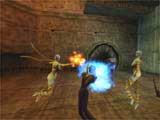 As players
proceed through the game, they will notice that every direction, every
surface can be explored. Actually, it’s inaccurate to talk about players
moving "through" this game because it suggests that Shadow
Man consists of logical levels and tiers which players must
"win" in order to move on to the next challenge until they get
to the game’s "end." There is nothing so predictably
teleological about Shadow Man, however. Indeed, perhaps this title’s
most compelling feature is its vast non-linear plot and design, both of
which seem to be infinite. Shadow Man will become legendary for the
amount of game time it provides players alone, which easily exceeds an
average work week.
As players
proceed through the game, they will notice that every direction, every
surface can be explored. Actually, it’s inaccurate to talk about players
moving "through" this game because it suggests that Shadow
Man consists of logical levels and tiers which players must
"win" in order to move on to the next challenge until they get
to the game’s "end." There is nothing so predictably
teleological about Shadow Man, however. Indeed, perhaps this title’s
most compelling feature is its vast non-linear plot and design, both of
which seem to be infinite. Shadow Man will become legendary for the
amount of game time it provides players alone, which easily exceeds an
average work week.
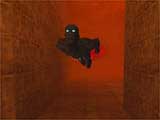 On the one hand,
Shadow Man’s non-linearity makes it a remarkably challenging and
surprising game—there is no way players can second-guess or anticipate
what’s coming next, even when successfully solving puzzles that will
obviously yield a certain expected result. Successfully acquiring enough
dark souls to access new Deadside portals, for example, does not prepare
players for the new landscapes and monsters beyond the gates. Another
particularly evocative element to all of this non-linear movement is Luke’s
teddy bear, which Mike/Shadow Man must use in order to travel from one
realm to another. On the other hand, the game’s relentlessly
non-sequential play requires players to traverse the same ground several
times over, thus making play at times frustratingly repetitious. While they
will find that this recursiveness allows them to acquire items and enter
areas previously beyond grasp or inaccessible during previous sojourns in
any given realm, players may get frustrated at having to decimate the same
zombies, ghouls and other horrors that swarm throughout the game. In
addition, demonic malignancies seem to increase in numbers and speed each
time players retrace their steps through increasingly familiar landscapes.
Perhaps there is a narrative purpose to this proliferation of evil,
though, that overrides the frustration of seemingly repetitious play.
Shadow Man, after all, is racing against the clock to prevent the
nefarious collective of doom known as Legion from acquiring enough dark
souls in order to flood Liveside with its burgeoning apocalyptic power,
thus claiming the ultimate empire in the name of eternal sorrow and
violence. So every time Shadow Man returns to certain points in the game,
he witnesses and potentially falls prey to the massing and increasingly
overwhelming forces of Legion. Players should note, too, that this
repetition occurs in two realms, Liveside and Deadside, and that they will
have different capabilities depending on who they are playing. Obviously,
Mike is much more vulnerable than Shadow Man, but still retains his
smarts, so Liveside play seems more cerebral at times than that of
Deadside. Fortunately, Mike figures out a way to tap into his Shadow Man
powers on the Liveside, and that’s when players get to tip over the
barrel of monkeys, dig?
On the one hand,
Shadow Man’s non-linearity makes it a remarkably challenging and
surprising game—there is no way players can second-guess or anticipate
what’s coming next, even when successfully solving puzzles that will
obviously yield a certain expected result. Successfully acquiring enough
dark souls to access new Deadside portals, for example, does not prepare
players for the new landscapes and monsters beyond the gates. Another
particularly evocative element to all of this non-linear movement is Luke’s
teddy bear, which Mike/Shadow Man must use in order to travel from one
realm to another. On the other hand, the game’s relentlessly
non-sequential play requires players to traverse the same ground several
times over, thus making play at times frustratingly repetitious. While they
will find that this recursiveness allows them to acquire items and enter
areas previously beyond grasp or inaccessible during previous sojourns in
any given realm, players may get frustrated at having to decimate the same
zombies, ghouls and other horrors that swarm throughout the game. In
addition, demonic malignancies seem to increase in numbers and speed each
time players retrace their steps through increasingly familiar landscapes.
Perhaps there is a narrative purpose to this proliferation of evil,
though, that overrides the frustration of seemingly repetitious play.
Shadow Man, after all, is racing against the clock to prevent the
nefarious collective of doom known as Legion from acquiring enough dark
souls in order to flood Liveside with its burgeoning apocalyptic power,
thus claiming the ultimate empire in the name of eternal sorrow and
violence. So every time Shadow Man returns to certain points in the game,
he witnesses and potentially falls prey to the massing and increasingly
overwhelming forces of Legion. Players should note, too, that this
repetition occurs in two realms, Liveside and Deadside, and that they will
have different capabilities depending on who they are playing. Obviously,
Mike is much more vulnerable than Shadow Man, but still retains his
smarts, so Liveside play seems more cerebral at times than that of
Deadside. Fortunately, Mike figures out a way to tap into his Shadow Man
powers on the Liveside, and that’s when players get to tip over the
barrel of monkeys, dig?
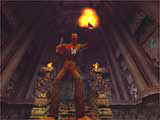 While the sheer variety and increasingly insurmountable crush of
creepily rendered evil creatures are enough to recommend Shadow Man
as the scariest PC entertainment ever produced, it is finally the sound
and score that make this title so frightening. Reviewing Thief: The
Dark Project about a year ago, this reviewer highlighted that title’s
sound as the star that stole the show. Shadow Man ups the ante by
coupling an eerie soundtrack with a brilliantly paced and edited score
that sonically conveys an all-encompassing, chilling sadness that makes Thief’s
zombies sound like kewpie dolls cooing "mama." For example, in Shadow
Man, zombies don’t simply grunt and moan; they weep, too,
reinforcing the idea that these beings are souls somehow sentient
of a past goodness that forever eludes them. Other creatures chitter and
whisper Shadow Man’s name, and still others mutter enraged curses and
threats. These hair-raising pronouncements are woven into a larger, subtle
music score that incorporates Middle Eastern-sounding chants and ambient
drumming that infuses the game, perhaps deceptively, with a hopeful tone.
The cumulative effect of all these aural textures is spine-tingling audio.
While the sheer variety and increasingly insurmountable crush of
creepily rendered evil creatures are enough to recommend Shadow Man
as the scariest PC entertainment ever produced, it is finally the sound
and score that make this title so frightening. Reviewing Thief: The
Dark Project about a year ago, this reviewer highlighted that title’s
sound as the star that stole the show. Shadow Man ups the ante by
coupling an eerie soundtrack with a brilliantly paced and edited score
that sonically conveys an all-encompassing, chilling sadness that makes Thief’s
zombies sound like kewpie dolls cooing "mama." For example, in Shadow
Man, zombies don’t simply grunt and moan; they weep, too,
reinforcing the idea that these beings are souls somehow sentient
of a past goodness that forever eludes them. Other creatures chitter and
whisper Shadow Man’s name, and still others mutter enraged curses and
threats. These hair-raising pronouncements are woven into a larger, subtle
music score that incorporates Middle Eastern-sounding chants and ambient
drumming that infuses the game, perhaps deceptively, with a hopeful tone.
The cumulative effect of all these aural textures is spine-tingling audio.
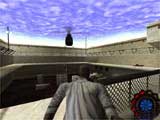 Throughout the
course of the game, Mike/Shadow Man acquires a number of weapons and
talismans (including protective tattoos) that aid him in his quest. In
closing, this fact bears mentioning to point out this review’s only
substantive criticism of the game. Namely, it’s distracting to have to
toggle to the select inventory screen in the midst of a given course of
action, be it exploration or melee, in which players will need to use a
variety of tools and weapons to accomplish a goal. The fact that
Mike/Shadow Man is ambidextrous offers little consolation in those
situations when players must, say, slaughter a dozen ghouls and elude
another dozen by leaping onto a ledge or up to a rope. Such fluid
sequences of moves are often required in Shadow Man, but often end
up being impossible to execute because players can not employ or put away
Mike/Shadow Man’s weapons and tools at the click of a button.
Throughout the
course of the game, Mike/Shadow Man acquires a number of weapons and
talismans (including protective tattoos) that aid him in his quest. In
closing, this fact bears mentioning to point out this review’s only
substantive criticism of the game. Namely, it’s distracting to have to
toggle to the select inventory screen in the midst of a given course of
action, be it exploration or melee, in which players will need to use a
variety of tools and weapons to accomplish a goal. The fact that
Mike/Shadow Man is ambidextrous offers little consolation in those
situations when players must, say, slaughter a dozen ghouls and elude
another dozen by leaping onto a ledge or up to a rope. Such fluid
sequences of moves are often required in Shadow Man, but often end
up being impossible to execute because players can not employ or put away
Mike/Shadow Man’s weapons and tools at the click of a button.
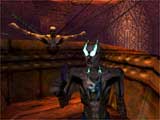 Well, reader, it’s doubtful that this review even begins to convey
what makes Shadow Man such a scary game. There’s a reason for
this. I’m not about to start describing all the sounds, sights and
notions that make this game so freaking hair-raising, especially since I’ve
just begun to get a full night’s worth of sleep after a month. Trust me,
though, if you’re looking for a PC game that radically undercuts and
challenges digital storytelling and immersive gameplay conventions, then
go out and get Shadow Man, which promises to be one of the most
talked about titles of this year … and bring enough extra cash to pick
up a nightlight while you’re at it.
Well, reader, it’s doubtful that this review even begins to convey
what makes Shadow Man such a scary game. There’s a reason for
this. I’m not about to start describing all the sounds, sights and
notions that make this game so freaking hair-raising, especially since I’ve
just begun to get a full night’s worth of sleep after a month. Trust me,
though, if you’re looking for a PC game that radically undercuts and
challenges digital storytelling and immersive gameplay conventions, then
go out and get Shadow Man, which promises to be one of the most
talked about titles of this year … and bring enough extra cash to pick
up a nightlight while you’re at it.

 Let’s
get one thing straight from the get-go. If you’re expecting to read
about Shadow Man as a spin-off from the popular Valiant Heroes
comic title, or about the particulars of the Shadow-Man story—that
Shadow Man is the heroic alter-ego of the shamed Mike LeRoi, a failed
English Literature student and New Orleans hitman, that the voodoo
priestess Nettie fused a voodoo mask to his sternum, or that this mask
gives LeRoi the power to move between the realms of Liveside and Deadside—then
find something else to read. See, I’m only going to talk about one thing
in respect to Shadow Man.
Let’s
get one thing straight from the get-go. If you’re expecting to read
about Shadow Man as a spin-off from the popular Valiant Heroes
comic title, or about the particulars of the Shadow-Man story—that
Shadow Man is the heroic alter-ego of the shamed Mike LeRoi, a failed
English Literature student and New Orleans hitman, that the voodoo
priestess Nettie fused a voodoo mask to his sternum, or that this mask
gives LeRoi the power to move between the realms of Liveside and Deadside—then
find something else to read. See, I’m only going to talk about one thing
in respect to Shadow Man.